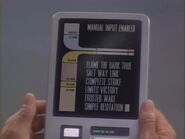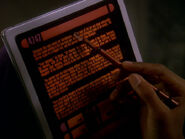JDspeeder1 (talk | contribs) |
JDspeeder1 (talk | contribs) |
||
| Line 82: | Line 82: | ||
{{bginfo|According to an in-depth article on PADDs in ''[[Star Trek: The Magazine]]'', several of the distinctly alien Cardassian PADDs were repainted Federation standard colors and used in the [[Star Trek films|movie]] {{film|8}}.|The Cardassian PADD was also fitted with a larger, lit display screen for use as scanners in ''Enterprise'', as an [[Earth]] device in {{e|Regeneration}} and [[Klingon]] device in {{e|Bounty}}.''}} |
{{bginfo|According to an in-depth article on PADDs in ''[[Star Trek: The Magazine]]'', several of the distinctly alien Cardassian PADDs were repainted Federation standard colors and used in the [[Star Trek films|movie]] {{film|8}}.|The Cardassian PADD was also fitted with a larger, lit display screen for use as scanners in ''Enterprise'', as an [[Earth]] device in {{e|Regeneration}} and [[Klingon]] device in {{e|Bounty}}.''}} |
||
| − | {{clear}} |
||
==Ferengi Alliance== |
==Ferengi Alliance== |
||
Revision as of 21:41, 10 August 2010
A 24th century Starfleet issue PADD
"PADD" is an acronym for Personal Access Display Device, a hand-held computer interface, used as early as the 22nd century and well into the 24th century.
PADDs were used by such space-faring organizations as Starfleet, the Andorian Imperial Guard, Bajoran Militia, Cardassian Union, Klingon Empire, Romulan Star Empire, and Vulcan High Command. They were common to cultures even as distant as the Delta Quadrant.
General Specifications
Inside a Starfleet PADD
Consisting of a large touchscreen display and minimalistic manual interface or control panel (generally only one or two buttons), the typical PADD is used for a variety of functions including logging manifests, compiling duty rosters or diagnostic reports, entering personal data, and/or accessing library computer systems.
Varying in size, shape and specification, PADDs are often distinguished by the species of their manufacturer or user. Earth and Federation Starfleet PADDs were generally flat and rectangular in shape, while Klingon and Cardassian PADDs were often more angular.
Starfleet
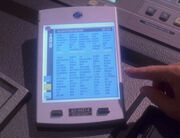
A typical PADD, 2151
Standard issue during the 22nd century, PADDs utilized by Starfleet were rectangular in shape, dominated by a large display screen taking up much of the surface area of the device. Small buttons were located just below the screen, most often grouped in two, at the lower right-hand side of the interface. Varying control button arrangements were also in use. (ENT: "Vox Sola", "Dead Stop")
These PADDs were often used to display schematics, or subspace transmissions and were capable of wireless computer networking as well as playing movies, recording logs and audio playback. (ENT: "Breaking the Ice", "Dawn", "Twilight")
At some point between 2144 and 2154, Arik Soong was able to open all the locks in the San Francisco prison he was being held at using just a PADD. After this incident, he was only allowed to use paper when sketching and writing his ideas. (ENT: "Borderland")
While under the effects of trellium-D in 2154, T'Pol shattered a PADD on Captain Archer's desk. (ENT: "Damage")
A Starfleet electronic clipboard, 2260s
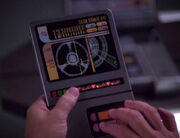
A Federation PADD, 2373
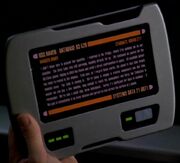
A horizontally held PADD
One of the most often used devices employed by personnel serving in Starfleet, PADDs were common aboard Federation starships, space stations, and planetary facilities during the 23rd and 24th centuries.
First appearing as late as 2266 aboard such starship types as the Template:ShipClass vessel, PADDs of the 2260s were large, wedge-shaped devices, operated almost exclusively through the use of a stylus. These data PADDs were often carried by yeomen aboard starships, but appeared in other locations including Starfleet's Starbase 11. (TOS: "The Man Trap", "The Menagerie, Part I", "The Menagerie, Part II"; DS9: "Trials and Tribble-ations")
By 2364, PADDs had taken on a smaller profile and, while some models would include one, the stylus was replaced by simple, touch-sensitive controls, generally located beneath a small, square-shaped display screen. Generally small and light-weight, the PADDs of the 2360s and 2370s were basically rectangular in shape, but varied in size, proportion, and even color – ranging from gray and muted blue colors, to red. Some PADDs, like the one used by Dr. Lewis Zimmerman aboard Jupiter Station in 2376, were translucent. (TNG: "Encounter at Farpoint"; DS9: "Emissary"; VOY: "Caretaker", "Life Line", et al.) When struck with enough force, the screen of a PADD could be shattered resulting in shards sharp enough to cut Human skin. (DS9: "Statistical Probabilities")
While the common function of these Federation PADDs was most often straight forward data entry or data retrieval, some PADDs were capable of more artistic tasks. Some PADDs, often larger in size than most of their counterparts, were used to draw up schematics or to create composite images or artwork. PADDs were also capable of predictive text functions, allowing users to enter a small amount of data to achieve full words or even sentences. In addition, a stylus could be used for text entry. (DS9: "Babel", "The House of Quark", "The Muse", "Image in the Sand")
Background information
PADDs as they were seen in the spin-off series were designed during the pre-production stage of Star Trek: The Next Generation, at least in part by Rick Sternbach. An early drawing (bearing a strong resemblance to the prop used well into Star Trek: Voyager) can be seen in the book, Star Trek: The Next Generation - The Continuing Mission, dated 17 March 1987.
Such 24th century PADDs first appeared in the episode "Lonely Among Us", where they are still called P.A.D.D. in the script. The device was also called P.A.D.D. in the script of "Too Short a Season". Beginning with "Loud As A Whisper", they were called PADDs or padds in the scripts. They were first mentioned by name in the episode "A Fistful of Datas".
Not long after their debut in TNG, PADDs became a real-life technology with the introduction of the Apple Newton; Palm Pilots being a similar device common in the world of the present. Recently, devices with touch-sensitive displays and user input systems which reconfigure themselves depending on the task at hand, such as the iPod Touch, iPhone, and most recently, the iPad have been developed which bear an even stronger resemblance to PADDs and the LCARS system.
Unlike their real world counterparts, most PADDs on TNG, DS9 and Voyager were nonfunctional, rarely even incorporating lighted display screens, but rather printed "okudagrams". This might suggest that some PADDs incorporate electronic paper technology. Lighted PADDs did eventually make their way to screens for Star Trek: Insurrection, with custom and store-bought devices like the Cabin Light Box, being used through Star Trek: First Contact and into Enterprise.
According to frequent background performer Guy Vardaman, TNG extras often referred to the PADD props they carried down corridors as "hall passes".
Several Federation PADDs were sold off on the It's A Wrap! sale and auction on eBay. [2] [3]
Andorian Imperial Guard
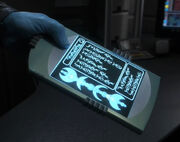
An Andorian PADD, 2154
Roughly the same size as their Earth Starfleet counterparts, PADDs used by officers in the service of the Andorian Imperial Guard were rectangular in shape, highlighted by several square-shaped pieces at the sides and top which itself was rounded.
Unlike the Starfleet version, no obvious buttons or control panels were visible on the device, suggesting that the large, center-mounted display screen was touch-sensitive. (ENT: "United")
Bajoran Militia
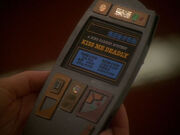
A Bajoran PADD, 2375
In use during the 24th century aboard Bajoran spacecraft and stations (including New Bajor and starbase Deep Space 9), Bajoran PADDs were small, roughly oval-shaped devices, nearly the same size as (though slimmer than) the small Federation PADD variant.
Capable of the same general function as their alien counterparts, Bajoran PADDs could be used to download information from primary computer sources, including text documents as large as novels. They were also able to display information in Bajoran as well as other languages. (DS9: "Emissary", "The Jem'Hadar", "Shadows and Symbols")
Cardassian Union
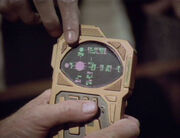
A Cardassian PADD, 2369
Used by both civilians and military personnel, the typical PADD used throughout the Cardassian Union could be found aboard Template:ShipClass warships and on Cardassia Prime itself.
Consisting of a brown and gold-colored unit, the Cardassian PADD was angular and irregularly shaped, featuring an oval-shaped display screen and a number of trapezoidal and irregularly shaped buttons.
The Cardassian PADD was capable of a variety of functions, from displaying visual recordings to operating door mechanisms. (TNG: "Chain of Command, Part II"; DS9: "Emissary", "Second Skin")
Ferengi Alliance
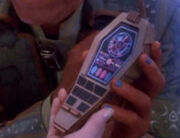
A common Ferengi PADD, 2374
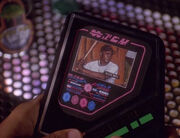
A PADD used at auction
A mainstay in business dealings involving Ferengi in and outside of the Ferengi Alliance, Ferengi PADDs were often elongated-hexagonally-shaped units. Muted gold in color, these PADDs featured a number of button controls and a hexagon-shaped viewscreen often displaying the familiar circular Ferengi interface layout.
Capable of cataloging inventory, inputting vouchers, or drawing up business plans, Ferengi PADDs were most often geared toward business and profit. Chief amongst their capabilities was currency transfer, allowing transactions to take place with simple thumb print verification. These PADDs were utilized by Ferengi Commerce Authority liquidators and could be found at the Tower of Commerce on Ferenginar, as well as aboard Ferengi vessels like Nunk's Marauder and at Quark's on Deep Space 9. (TNG: "Firstborn"; DS9: "The Wire", "Family Business", "The Begotten", "Profit and Lace"; VOY: "Inside Man")
Other Ferengi PADD variants included a flat, black and green device with an angular display screen. This PADD variant could be used to view auction catalogs. (DS9: "In the Cards")
Klingon Empire
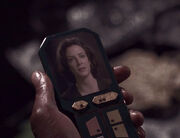
A small Klingon PADD in 2373
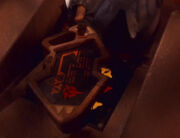
A larger Klingon PADD variant
At least two models of data PADDs were used by warriors in the service of the Klingon Defense Force during the 24th century.
Both harshly angular compared to their Federation counterparts, Klingon PADDs came in hand-held and larger, landscape-style varieties. Both displaying information in Klingonese, these PADDs could be found in the chambers of the Klingon High Council on Qo'noS as well as aboard Klingon vessels such as the IKS Rotarran.
The smaller model was dark green in color and featured several button controls running up the center of the device to a rectangular-shaped display screen capable of recorded-video playback. The larger model was brown and was held horizontally with a handle attached to the left of an angular, touch screen display. (DS9: "The House of Quark", "Blaze of Glory", "Soldiers of the Empire", "Tacking Into the Wind")
Quarren
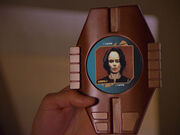
A Quarren PADD, 2377
An example of PADDs appearing as distant as the Delta Quadrant, similar devices were utilized by the slavers of the planet Quarra in 2377.
Golden-brown in color, these PADDs were roughly the same size as their Alpha/Beta Quadrant counterparts, but featured circular display screens with several button controls below. Among their functions, they were used to display missing persons reports. (VOY: "Workforce", "Workforce, Part II")
Vulcan
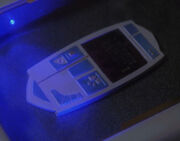
A Vulcan PADD, 2152
In service as early as the 22nd century, Vulcan PADDs came in a variety of builds and sizes, from angular to oval-shaped devices.
These PADDs were used by Vulcans stationed on distant planets, including Vulcans serving in the Interspecies Medical Exchange on Dekendi III. (ENT: "Stigma")
References
External links
- Template:Exastris
- LCARS PADD: A Nokia 770 look for the 24th century at Synthesize.us

